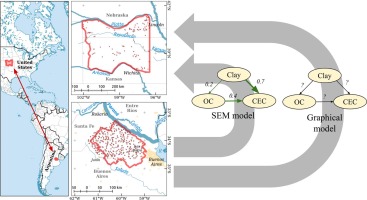Our official English website, www.x-mol.net, welcomes your feedback! (Note: you will need to create a separate account there.)
Extrapolation of a structural equation model for digital soil mapping
Geoderma ( IF 6.1 ) Pub Date : 2020-05-01 , DOI: 10.1016/j.geoderma.2020.114226 M.E. Angelini , B. Kempen , G.B.M. Heuvelink , A.J.A.M. Temme , M.D. Ransom
Geoderma ( IF 6.1 ) Pub Date : 2020-05-01 , DOI: 10.1016/j.geoderma.2020.114226 M.E. Angelini , B. Kempen , G.B.M. Heuvelink , A.J.A.M. Temme , M.D. Ransom

|
Abstract In theory, two separate regions with the same soil-forming factors should develop similar soil conditions. This theoretical finding has been used in digital soil mapping (DSM) to extrapolate a model from one area to another, which usually does not work out well. One reason for failure could be that most of these studies used empirical methods. Structural equation modelling (SEM) is a semi-mechanistic technique, which can explicitly include expert knowledge. We therefore hypothesize that SEM models are more suitable for extrapolation than purely empirical models in DSM. The objective of this study was to investigate the extrapolation capability of SEM by comparing different model settings. We applied a SEM model from a previous study in Argentina to a similar soil-landscape in the Great Plains of the United States to predict clay, organic carbon, and cation exchange capacity for three major horizons: A, B, and C. We concluded that system relationships that were well supported by pedological knowledge showed consistent and equal behaviour in both study areas. In addition, a deeper understanding of indicators of soil-forming factors could strengthen conceptual models for extrapolating DSM models. We also found that for model extrapolation, knowledge-based links between system variables are more effective than data-driven links. In particular, model modifications can improve local prediction but harm the predictive power of extrapolation.
中文翻译:

数字土壤测绘的结构方程模型外推
摘要 理论上,具有相同成土因素的两个不同区域应该形成相似的土壤条件。这一理论发现已用于数字土壤制图 (DSM),以将模型从一个区域外推到另一个区域,但通常效果不佳。失败的原因之一可能是这些研究中的大多数使用了经验方法。结构方程建模 (SEM) 是一种半机械技术,可以明确地包含专家知识。因此,我们假设 SEM 模型比 DSM 中的纯经验模型更适合外推。本研究的目的是通过比较不同的模型设置来研究 SEM 的外推能力。我们将之前在阿根廷进行的一项研究中的 SEM 模型应用于美国大平原的类似土壤景观,以预测粘土,三个主要层面的有机碳和阳离子交换能力:A、B 和 C。我们得出结论,得到土壤学知识充分支持的系统关系在两个研究领域表现出一致和平等的行为。此外,更深入地了解土壤形成因素的指标可以加强用于外推 DSM 模型的概念模型。我们还发现,对于模型外推,系统变量之间基于知识的链接比数据驱动的链接更有效。特别是,模型修改可以改善局部预测,但会损害外推的预测能力。更深入地了解土壤形成因素的指标可以加强用于外推 DSM 模型的概念模型。我们还发现,对于模型外推,系统变量之间基于知识的链接比数据驱动的链接更有效。特别是,模型修改可以改善局部预测,但会损害外推的预测能力。更深入地了解土壤形成因素的指标可以加强用于外推 DSM 模型的概念模型。我们还发现,对于模型外推,系统变量之间基于知识的链接比数据驱动的链接更有效。特别是,模型修改可以改善局部预测,但会损害外推的预测能力。
更新日期:2020-05-01
中文翻译:

数字土壤测绘的结构方程模型外推
摘要 理论上,具有相同成土因素的两个不同区域应该形成相似的土壤条件。这一理论发现已用于数字土壤制图 (DSM),以将模型从一个区域外推到另一个区域,但通常效果不佳。失败的原因之一可能是这些研究中的大多数使用了经验方法。结构方程建模 (SEM) 是一种半机械技术,可以明确地包含专家知识。因此,我们假设 SEM 模型比 DSM 中的纯经验模型更适合外推。本研究的目的是通过比较不同的模型设置来研究 SEM 的外推能力。我们将之前在阿根廷进行的一项研究中的 SEM 模型应用于美国大平原的类似土壤景观,以预测粘土,三个主要层面的有机碳和阳离子交换能力:A、B 和 C。我们得出结论,得到土壤学知识充分支持的系统关系在两个研究领域表现出一致和平等的行为。此外,更深入地了解土壤形成因素的指标可以加强用于外推 DSM 模型的概念模型。我们还发现,对于模型外推,系统变量之间基于知识的链接比数据驱动的链接更有效。特别是,模型修改可以改善局部预测,但会损害外推的预测能力。更深入地了解土壤形成因素的指标可以加强用于外推 DSM 模型的概念模型。我们还发现,对于模型外推,系统变量之间基于知识的链接比数据驱动的链接更有效。特别是,模型修改可以改善局部预测,但会损害外推的预测能力。更深入地了解土壤形成因素的指标可以加强用于外推 DSM 模型的概念模型。我们还发现,对于模型外推,系统变量之间基于知识的链接比数据驱动的链接更有效。特别是,模型修改可以改善局部预测,但会损害外推的预测能力。


























 京公网安备 11010802027423号
京公网安备 11010802027423号